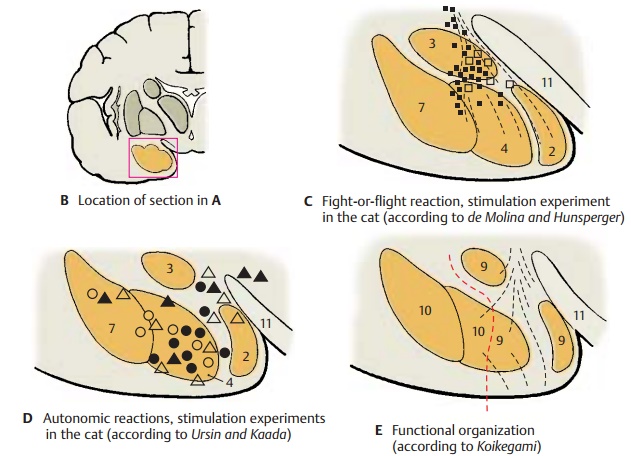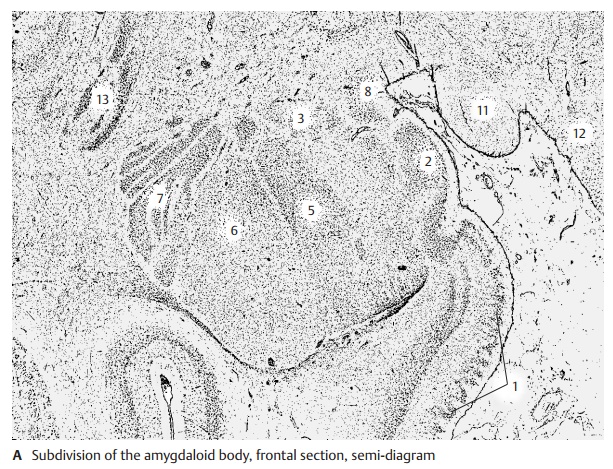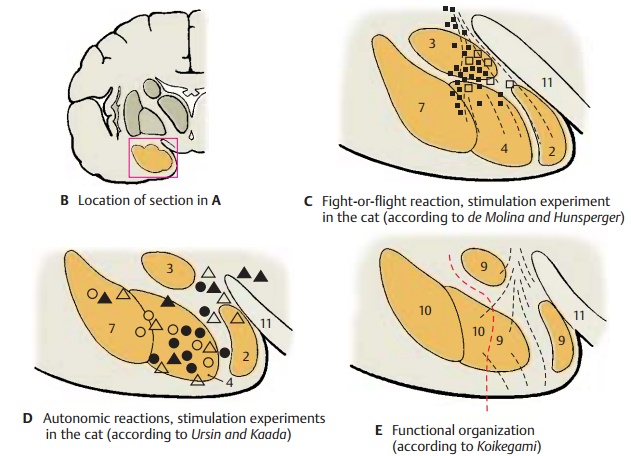Chapter: Human Nervous System and Sensory Organs : Telencephalon
Amygdaloid Body

Amygdaloid Body
The amygdaloid body (amygdala) lies at the medial aspect of the temporal lobe (B). It consists of a cortical part, the cortical nu-cleus, and a nuclear part lying in the depth;hence, it must be viewed as a transition be-tween cortex and nucleus. The nuclear com-plex is covered by the periamygdalar cortex (A1).

Subnuclei (A – D)
The complex is divided into several subnu-clei, namely, the superficial cortical nucleus (ACD2), the central nucleus (ACD3), the basal nucleus(CD4) consisting of a parvo-cellular medial part (A5) and a magnocellu-lar lateral part (A6), and the lateral nucleus (ACD7). The assignment of the medial nu-cleus (A8) to the amygdala complex is questionable. The amygdaloid body is rich in peptidergic neurons. Primarily enkephalin and corticoliberin can be dem-onstrated in the central nucleus and VIP in the lateral nucleus.
The subnuclei form two groups: the phylo-genetically old corticomedial group (corticalnucleus, central nucleus) and the phylo-genetically youngerbasolateral group (basalnucleus, lateral nucleus). The corticomedialgroup receives fibers of the olfactory bulb and is the area of origin of the stria termi-nalis. The basolateral group has fiber con-nections with the prepiriform area and the entorhinal area. Electrophysiological re-cordings have demonstrated that only the corticomedial group receives olfactory im-pulses, while the basolateral group receives optic and acoustic impulses.

Functional Organization (C – E)
Electrical stimulation of the amygdala and its surroundings induces autonomic andemotional responses. Anger (!) or flight re-action (") with the corresponding auto-nomic phenomena (dilatation of pupils, rise in blood pressure, increase in cardiac and respiratory rates) can be triggered by stimu-lation of the collecting area of the stria ter-minalis fibers (C). Other sites produce reac-tions of alertness associated with turningthe head. Stimulation may induce chewing (#), licking ($), or salivation (%) (D). It may also result in food uptake, secretion of gas-tric juice, and increased intestinal motility or bulimia. Hypersexuality may occur as a result of stimulation but may also be pro-duced by lesions to the basolateral group of nuclei.Urination (&) or defecation may be induced as well.
The stimulation responses are difficult to arrange topically; many fibers run through the nuclear complex, and the stimulation responses may originate not only from the site of stimulation but also from affected fiber bundles of other nuclei. The medial part of the basal nucleus has been assigned to the corticomedial group of nuclei, and an attempt has been made to correlate the two nuclear groups with the different re-sponses; the corticomedial group (E9) is thought to promote aggressive behavior,sexual drive, and appetite, while the lateralgroup (E10) has an inhibitory effect.
Clinical Note: Stimulation of the amygdaloidbody in humans (a diagnostic measure in the treatment of severe epilepsy) may trigger anger or anxiety, but also a feeling of tranquillity and re-laxation. The patients may feel “transformed” or “in a different world”. The response will essen-tially be influenced by the emotional state at the onset of the stimulation.
A–E11 Optic tract.
A12 Hypothalamus.
A13 Claustrum.
Related Topics